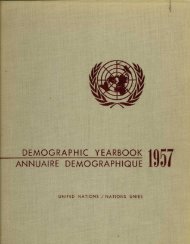Transliteration from Hebrew into Arabic
Transliteration from Hebrew into Arabic
Transliteration from Hebrew into Arabic
You also want an ePaper? Increase the reach of your titles
YUMPU automatically turns print PDFs into web optimized ePapers that Google loves.
United Nations E/CONF.98/ 5/Add.1<br />
Economic and Social Council<br />
Ninth United Nations Conference on the<br />
Standardization of Geographical Names<br />
New York, 21 - 30 August 2007<br />
Item 16 (b) of the provisional agenda*<br />
Conversion <strong>into</strong> Non-Roman writing systems<br />
<strong>Transliteration</strong> <strong>from</strong> <strong>Hebrew</strong> <strong>into</strong> <strong>Arabic</strong><br />
Submitted by Israel**<br />
_____________________________<br />
* E/CONF.98/1<br />
** Prepared by Naftali Kadmon, The <strong>Hebrew</strong> University of Jerusalem, Israel.<br />
Distr.: General<br />
15 June 2007<br />
Original: English
<strong>Transliteration</strong> <strong>from</strong> <strong>Hebrew</strong> <strong>into</strong> <strong>Arabic</strong><br />
Paper presented by Israel<br />
This transliteration system which is now official in Israel, as described in the national report of<br />
Israel under item 4 of the provisional agenda, had to solve the problem of the <strong>Hebrew</strong> consonants ?,<br />
? (both romanized as v), ? (hard g), ? (p) and ? (ts) as well as the vowels e and o , which all have<br />
no direct formal equivalent in the classical <strong>Arabic</strong> alphabet. In the case of most <strong>Hebrew</strong> consonant<br />
letters there is no problem, because the majority of <strong>Hebrew</strong> letters have a direct and precise<br />
equivalent in <strong>Arabic</strong>. However, there are the above exceptions. This is distinct <strong>from</strong> e.g. Egyptian<br />
<strong>Arabic</strong> in which the letter jim is the equivalent of <strong>Hebrew</strong> ? (gimmel) and pronounced not as j but as<br />
a hard g. However, some Persian and Malay (Jawi) consonant letters are already being widely used<br />
in the <strong>Arabic</strong> transliteration of western words, among others in the <strong>Arabic</strong> press in Israel, and these<br />
have been incorporated in the new rules to represent the three <strong>Hebrew</strong> consonant letters for g, p and<br />
v. Thus, <strong>Hebrew</strong> ? (g) is represented by Persian ch (<strong>Arabic</strong> g but with three dots below it); <strong>Hebrew</strong><br />
pe (p) by Persian p (<strong>Arabic</strong> b but with three dots below); and <strong>Hebrew</strong> undotted bet , ? (v) as well as<br />
? which have no equivalent in <strong>Arabic</strong>, and their Persian equivalent is the <strong>Arabic</strong> letter for w (waw),<br />
is represented by the Malay letter for p, i.e. <strong>Arabic</strong> f but with three dots above it.<br />
Both <strong>Hebrew</strong> and <strong>Arabic</strong> are defective alphabetic scripts; vowels are mostly represented by<br />
markers. But whereas <strong>Hebrew</strong> has five basic vowel sounds (a, e, i, o, u) with some modifications,<br />
<strong>Arabic</strong> has three – fat'ha, dammah and kasra (a, u, i) with their phonetic variants. Adequate<br />
approximation to <strong>Hebrew</strong> e and o had to be introduced. Stress, too, has to be accounted for, often<br />
introducing an additional alif, ya or waw just as in <strong>Hebrew</strong> plene orthography. Word endings, too,<br />
have to be adapted, and in certain cases fat'ha-alif substitute for <strong>Hebrew</strong> kammats-he. The system<br />
has chiefly to serve <strong>Arabic</strong> -reading users of road signs and maps and enable them to read <strong>Hebrew</strong><br />
place names in Israel.<br />
Abstract<br />
The new transliteration system <strong>from</strong> <strong>Hebrew</strong> <strong>into</strong> <strong>Arabic</strong> was ratified in .May 2007. It<br />
solves the problem of properly representing the four <strong>Hebrew</strong> consonant letters ?, ?, ? and ? as well<br />
as the vowels e and o, which have no equivalent in classical <strong>Arabic</strong>, by letters <strong>from</strong> the Persian and<br />
Malay (Jawi) alphabets. Stress and word endings were also dealt with. The system is intended<br />
chiefly to serve <strong>Arabic</strong>-reading users of road signs and maps and enable them to read <strong>Hebrew</strong> place<br />
names in Israel.
















